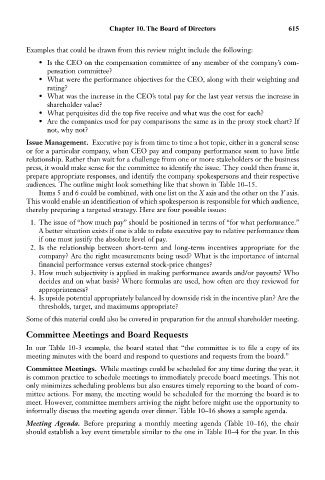Page 630 - Bruce Ellig - The Complete Guide to Executive Compensation (2007)
P. 630
Chapter 10. The Board of Directors 615
Examples that could be drawn from this review might include the following:
• Is the CEO on the compensation committee of any member of the company’s com-
pensation committee?
• What were the performance objectives for the CEO, along with their weighting and
rating?
• What was the increase in the CEO’s total pay for the last year versus the increase in
shareholder value?
• What perquisites did the top five receive and what was the cost for each?
• Are the companies used for pay comparisons the same as in the proxy stock chart? If
not, why not?
Issue Management. Executive pay is from time to time a hot topic, either in a general sense
or for a particular company, when CEO pay and company performance seem to have little
relationship. Rather than wait for a challenge from one or more stakeholders or the business
press, it would make sense for the committee to identify the issue. They could then frame it,
prepare appropriate responses, and identify the company spokespersons and their respective
audiences. The outline might look something like that shown in Table 10–15.
Items 5 and 6 could be combined, with one list on the X axis and the other on the Y axis.
This would enable an identification of which spokesperson is responsible for which audience,
thereby preparing a targeted strategy. Here are four possible issues:
1. The issue of “how much pay” should be positioned in terms of “for what performance.”
A better situation exists if one is able to relate executive pay to relative performance than
if one must justify the absolute level of pay.
2. Is the relationship between short-term and long-term incentives appropriate for the
company? Are the right measurements being used? What is the importance of internal
financial performance versus external stock-price changes?
3. How much subjectivity is applied in making performance awards and/or payouts? Who
decides and on what basis? Where formulas are used, how often are they reviewed for
appropriateness?
4. Is upside potential appropriately balanced by downside risk in the incentive plan? Are the
thresholds, target, and maximums appropriate?
Some of this material could also be covered in preparation for the annual shareholder meeting.
Committee Meetings and Board Requests
In our Table 10-3 example, the board stated that “the committee is to file a copy of its
meeting minutes with the board and respond to questions and requests from the board.”
Committee Meetings. While meetings could be scheduled for any time during the year, it
is common practice to schedule meetings to immediately precede board meetings. This not
only minimizes scheduling problems but also ensures timely reporting to the board of com-
mittee actions. For many, the meeting would be scheduled for the morning the board is to
meet. However, committee members arriving the night before might use the opportunity to
informally discuss the meeting agenda over dinner. Table 10–16 shows a sample agenda.
Meeting Agenda. Before preparing a monthly meeting agenda (Table 10–16), the chair
should establish a key event timetable similar to the one in Table 10–4 for the year. In this

